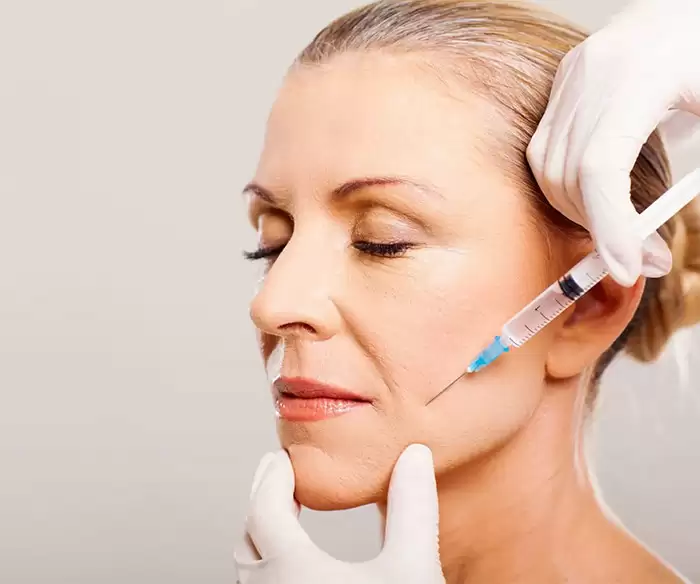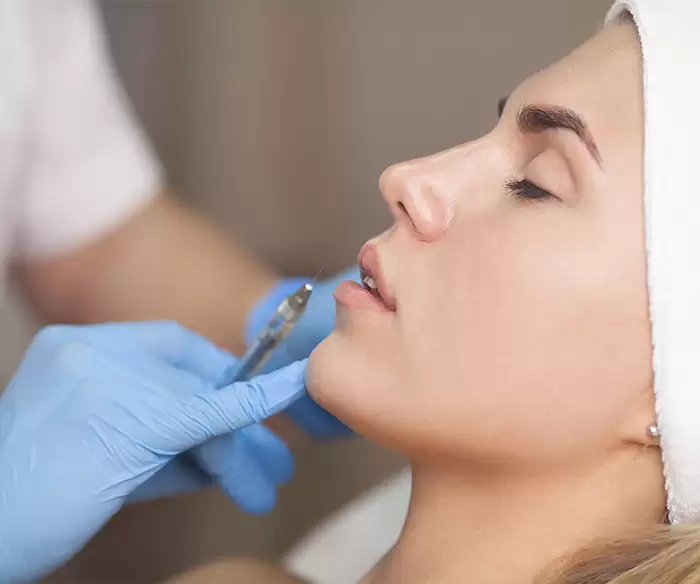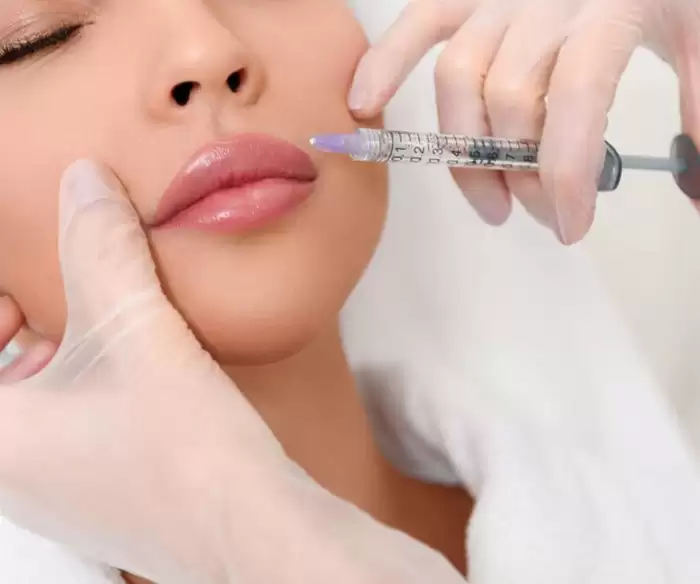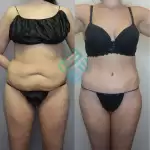Office Address
Veliefendi, Prof. Dr. Turan Güneş Cd. no:107, 34025 Zeytinburnu/İstanbul
Phone Number
(0212) 890 50 54
Email Address
info@ehtclinic.com
Dermal Fillers in Turkey
Make Your Request

What Is Dermal Filling and How Is It Done?
In comparison to other common aesthetic procedures like face lifts, fillers are one of the non-surgical methods for giving you a younger appearance. Hyaluronic acid, elastin, and collagen fibers are some of the structural components of the skin that are lost as we age, contributing to wrinkles and drooping. Dermal fillers are a common and popular injectable treatment that can be used to treat age-related conditions as well as a cosmetic technique to help straighten nose imperfections and give volume to lips, for instance. A straightforward injection under the skin along with local anesthetic is used to fill the region. Fillers are compounds that are temporarily, semi-permanently, or permanently injected under the skin to treat scars, wrinkles, sagging skin, and other skin conditions.
What is in Dermal Fillers?
Dermal fillers come in a variety of forms, including:
- Hyaluronic acid (HA):It is an acid that naturally exists in your skin. Your skin gets volume from it, and it stays moisturized.
- Calcium hydroxylapatite (CaHA):It is a kind of filler made from a material found in your bones. For deeper wrinkles, physicians typically employ CaHA fillers.
- Poly-L-lactic acid (PLLA):It is a chemical that aids in the body's production of collagen. Poly-L-lactic acid is typically used by medical professionals to treat deep facial creases.
- Polymethylmethacrylate (PMMA):These tiny balls of collagen-based filler remain under your skin after being injected by your doctor. Your skin has volume from the balls, which also keep it firm.
- Human Fat:To improve facial fullness, fill in deep creases, and build up shallow contours, the doctor may remove fat from the patient's own body and reinject it.
Types of Dermal Fillers
- Lip Filling:The injections known as lip fillers give your lips more volume. They don't stop the aging process, but they could put off the need for a lip lift or more invasive surgical lip augmentation.
- Nose Filling:Nasal filling is referred to as non-operative rhinoplasty. Many nasal abnormalities can be quickly and comfortably fixed with nasal filling.
- Jawline Fill:A nonsurgical cosmetic surgery called jawline filler offers your jaw area a more defined appearance. Under your skin, your doctor injects fillers, which are safe ingredients. Your skin is plumped up by the filler.
- Under Eye Light Filling:The body requires hyaluronic acid filler, which is used to alleviate bruising and bags under the eyes. It can be completed without the need for surgery. Tools for injecting fine-tipped filler are utilized for this application.
- Cheekbone Filling:Injections called cheek fillers increase the volume of the skin above and around the cheekbones. This gives the appearance that the bone structure is more clearly delineated. Cheek fillers can help reduce wrinkles and fine lines by adding volume beneath the skin's surface.
- Temple Filling:Non-surgical injections called "temple fillers" rejuvenate the temples like a mini-facelift. Using a biodegradable hyaluronic acid (HA) gel, they restore hydration and volume to the temporal region.
- Chin Filling:An injection of chin filler is a nonsurgical technique that modifies the chin's shape and definition. Chin fillers can strengthen the jawline, giving the face a more youthful appearance.
- Cheek Filling:Your cheeks will look larger and more defined after receiving cheek filler, a nonsurgical cosmetic surgery. Dermal fillers, which are safe ingredients, are injected by a medical professional above and around your cheekbones.
- Moisture Vaccine and Moisture Filling:A new line of aesthetic products called moisture vaccines erase wrinkles and sags brought on by water loss in the skin and delay the development of new wrinkles and sags by making the skin more flexible.
- Nasolabial Filling:Laugh lines are another name for nasolabial folds. As people get older, they look deeper due to sagging and volume loss. Nasolabial (laugh) line fillers restore volume and increase collagen formation, minimizing the appearance of facial lines, creases, and folds that emerge when we smile and making people appear more youthful.
- Face Filling:Fillers are used to smooth out deep and shallow wrinkles in the skin, cure scars, heal collapses in the skin, thicken thin lips, shape the lips, and reshape the cheekbone. A youthful appearance is given right away following the face filler. Face filling eliminates the fatigued expression on the face.
- Eyelid Filler:For this area, fat injections are preferred. A specific cannula is used to extract the person's fat cells, which is then thinly placed under the skin in this location. If the patient is to have lower eyelid aesthetics performed, this adipose tissue can also be removed from the lower eyelid.
- Hand Filling:Multiple sites on the skin's dermal layer can be used to inject dermal fillers. The filler is frequently "liquid," allowing for greater coverage before firming up. Fillers can give the hands a youthful appearance.
- G Spot Filling:It is a well-liked, simple process that can significantly increase your sex life. A hyaluronic acid dermal filler is used to fill in the area, which is roughly 2 inches deep and situated on the anterior of the vagina. Your g spot can become more noticeable and simpler to locate by doing this.

Is Dermal Filling Suitable for All Skin Types?
Yes. Dermal fillers are not suitable for everyone, though. People with specific illnesses, such as bleeding disorders or certain allergies, may not be a good candidate for dermal fillers. If your doctor says dermal fillers are a possibility for you, be aware that all medical products have advantages and disadvantages.
Who Is a Good Candidate for Dermal Fillers?
- If you are older than 18,
- If you don't have high blood pressure or hepatitis,
- If you are a healthy person in general,
- If you are not pregnant or breastfeeding,
- If you don’t have allergies to fillers,
- If you wish to give your face a rejuvenated and fresh appearance, you are a suitable candidate for dermal fillers.
Things to Consider Before Dermal Fillers
- For a week before the procedure, refrain from taking any aspirin or ibuprofen, as well as any substances that thin the blood and vitamin E.
- Avoid topical products containing Glycolic Acid, Tretinoin (Retin-A), Retinol, Retinoids, or any other "anti-aging" ingredients.
- Before the procedure, you should give up drinking and smoking for a week.
- Your doctor will perform a medical exam to evaluate your overall health, family history, and procedure eligibility.
- On the area that will be treated, refrain from waxing, bleaching, tweezing, or applying hair removal cream.
- You should remove your make-up before the treatment.

Things to Consider After Dermal Fillers
- You should wait 24 hours before drinking alcohol or smoking after the injection.
- You shouldn't touch or rub your face for three days after the procedure.
- Take the drugs that your doctor has advised you to take.
- Avoid applying high heat to the treated area until the oedema and redness have subsided. Sunbathing, tanning, saunas, hot tubs, or hot wax all fall under this category.
- You should use gentle cleansers if you have make up.
How Long Is the Recovery?
You are not required to remain at the hospital or clinic. You are prepared to go after the filler procedure, which takes about 15 minutes. You'll have local anaesthetic and recover the following day.
Are Dermal Filler Results Permanent?
Dermal fillers come in three varieties: temporary, semi-permanent, and permanent. The most popular kind of dermal fillers are temporary ones.
- Temporary dermal fillers come in three different varieties: those made of hyaluronic acid, collagen, and calcium hydroxylapatite. Depending on how many injections you have, temporary fillers typically last anywhere from six months to a year. Because semi-permanent fillers are more thick than temporary fillers, the body takes much longer to digest and absorb them.
- Semi-permanent fillers, which are made of a synthetic substance called poly-L-lactic acid, are frequently used to repair deeper laugh lines, marionette lines, wrinkles, and crow's feet. In between 12 and 18 months, they last. The most viscous among them are the temporary dermal fillers.
- Permanent dermal fillers can't be decomposed, which means the body can't break them down as quickly as temporary and semi-permanent fillers can. They have an average lifespan of five years.
Dermal Fillers Prices in Turkey
Turkish prices for dermal fillers are lower than those in the US, Canada, the UK, or other European countries. It is less than half as expensive. Turkey's cost of living is reasonable for a variety of reasons. Turkey's capacity to produce items at rates that are competitive in the market is impacted by a number of factors. Compared to the dollars, pounds, and euros, the Turkish lira is initially less valuable. Turkish clinics are still able to keep their costs low. Turkey also has a lot of plastic surgery clinics, which boosts competition and drives down costs. Dermal fillers may also cost more or less based on a person's health and physical characteristics. The strategy taken during the procedure and the doctor's level of experience both have an impact on the cost. Thus, evaluation is essential. If you have any questions about how much dermal fillers cost in Turkey, please get in touch with us.







